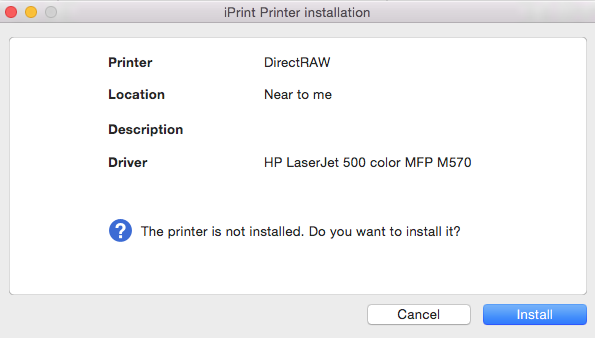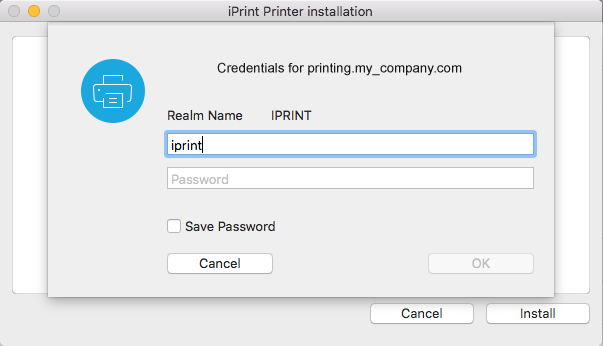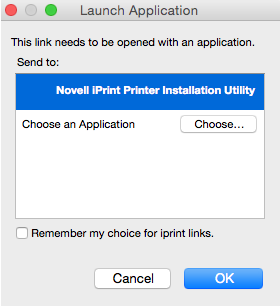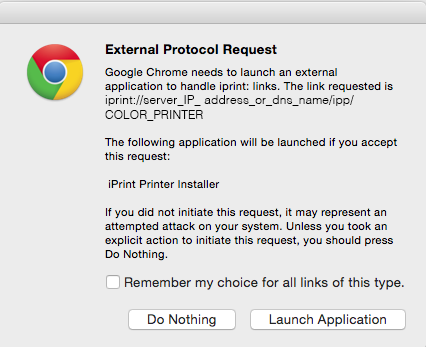11.4 Macintosh: Installing Printers
When installing a printer if the iPrint Client is not installed, you will be prompted for installation. You can install the printers in a variety of ways:
11.4.1 IPP Page
You can install the iPrint printers using the following browsers:
On Safari
-
Launch the browser, and use either the host name or the IP address to access the iPrint Printer List page.
For example, http://server_IP_ address_or_dns_name/ipp.
All the available printers are listed on the iPrint Printer List web page.

-
Click on the printer that you want to install.
The iPrint Printer Installation dialog box is displayed.

-
Click Install to proceed with the installation of the printer.
-
If you are installing a secure printer, the iPrint Printer Installation dialog box prompts for user credentials.

-
Specify user credentials.
-
(Optional) To avoid future prompts, select Save Password check box.
-
Click OK after you have specified your credentials.
-
-
Click OK when the printer installation is complete.
On Mozilla Firefox
-
Launch the browser, and use either the host name or the IP address to access the iPrint Printer List page.
For example, http://server_IP_ address_or_dns_name/ipp.
All the available printers are listed on the iPrint Printer List web page.

-
Click on the printer that you want to install.
The Launch Application dialog box is displayed.

-
Select Novell iPrint Printer Installation Utility in the Launch Application dialog box, then click OK to proceed with the installation of the printer.
-
(Optional) To avoid future prompts to launch the iPrint applications, select Remember my choice for iPrint links check box.
The iPrint Printer Installation dialog box is displayed.

-
Click Install to proceed with the installation of the printer.
-
If you are installing a secure printer, the iPrint Printer Installation dialog box prompts for user credentials.

-
Specify user credentials.
-
(Optional) To avoid future prompts, select Save Password check box.
-
Click OK after you have specified your user credentials, then click OK to proceed with the installation of the printer.
-
-
Click OK when the printer installation is complete.
On Google Chrome
-
Launch the browser, and use either the host name or the IP address to access the iPrint Printer List page.
For example, http://server_IP_ address_or_dns_name/ipp.
All the available printers are listed on the iPrint Printer List web page.

-
Click on the printer that you want to install.
The External Protocol Request dialog box is displayed.

-
Click Launch Application on the External Protocol Request dialog box to proceed with the installation of the printer.
-
(Optional) To avoid future prompts to launch external protocol links, select the Remember my choice for all links of this type check box.
The iPrint Printer Installation dialog box is displayed.

-
Click Install to proceed with the installation of the printer.
-
If you are installing a secure printer, the iPrint Printer Installation dialog box prompts for user credentials.

-
Specify user credentials.
-
(Optional) To avoid future prompts, select Save Password check box.
-
Click OK after you have specified your user credentials, then click OK to proceed with the installation of the printer.
-
During the printer installation, iPrint downloads and installs the printer driver, if one is associated with the printer, and installs the printer on the user’s workstation. The first time a printer is installed, printer drivers are forced to the workstation, even if the workstation contains a newer driver. Print Managers refresh their saved copies of printer drivers for the printers they are hosting with updated printer drivers from the associated Driver Store.
11.4.2 Command Line (iprntcmd)
The Macintosh iPrint Clients include the iprntcmd utility that performs the same functions as iprntcmd in the Windows iPrint Client. In addition, you can use iprntcmd to upload PPD drivers to a Driver Store from the iPrint Client. iprntcmd is located in /usr/bin on Macintosh.
Use the following parameters when executing the iprntcmd command:
Table 11-3 Parameters Used with iprntcmd
|
Parameters |
Description |
|---|---|
|
-T | --tray-icon |
Displays an iPrint icon to the notification area and starts the iprint-listener-gui process, if it is not running. |
|
-r | --run-listener |
Launches the iprint-listener process if it is not already running. |
|
-a or --addprinter <printer_uri> |
Installs the specified printer. |
|
-d or --delprinter <printer_uri> |
Removes the specified printer. |
|
-d or --delprinter all |
Removes all printers. This option requires your confirmation before removing all the printers. |
|
-d or --delprinter all --force |
Remove all the printers. This option removes all the printers forcibly without any user intervention. |
|
-g or --getdefault |
Displays the default printer installed on the workstation. |
|
-h or --help |
Displays help for the command. |
|
-j or --listjobs <printer_uri> |
Lists the print jobs for the specified printer that are on the server in a pending or printing state. |
|
-l or --listprinters |
Lists printers installed on the workstation. |
|
-L or --listprintersonserver <psm-hostname or psm-address> |
Lists iPrint printers on the specified Print Manager where psm-hostname or psm-address can be a host name or IP address. |
|
-p or --printfile <printer-uri filepath> |
Sends a printer-ready file to the specified iPrint printer. |
|
-P or --ppdlist |
Lists the PPDs installed on this workstation. |
|
-s or --setdefault <printer_uri> |
Sets the specified printer as the default. |
|
-t or --testpage <printer_uri> |
Prints a test page to the specified printer. |
|
-u or --uploadids <ids_uri> <ppd with/without a wildcard> |
Uploads the specified PPD files to the indicated Driver Store where ids_uri is the IP address or host name for the Driver Store, and ppd is the directory path and filename to the PPD files. You can use a wildcard in the PPD filename. |
|
-U or --uploadbroker <rms_uri> <rms_name> <ppd with/without a wildcard> |
Uploads the specified PPD files to the indicated Broker where rms_uri is the IP address or host name for the Broker’s associated Print Manager, rms_name is the username with rights to add drivers to the broker, and ppd is the directory path and filename to the PPD files. You can use a wildcard in the PPD filename. |
|
-U | --uploaddriver [osx] <ids_uri> <username> <password> [INF-Filepath <model-name>] | [driver-Filepath] |
Uploads the specified PPD files to the indicated Driver Store where ids_uri is the IP address or host name for the Driver Store, and INF-Filepath is the path of the driver package, and driver-Filepath is the path of the printer driver file. |
|
-v or --version <psm-hostname or psm-address> |
Displays the server platform and version information where server_uri is the URI for the server. |
|
-i or --info <printer-uri> |
Displays the printer information. |
Syntax
iprntcmd options parameters
You must use quotes around parameter information that contains a space, such as printer names and printer drivers.
Example
To install a printer named Color Printer 1 and set it as the default printer, enter the following:
iprntcmd -a "ipp://printing.my_company.com/ipp/Color Printer 1"
iprntcmd --setdefault "ipp://printing.my_Company.com/ipp/Color Printer 1"
For uploading PPD files from Mac clients, enter the following:
iprntcmd -u <ids-hostname or ids-address> <ppd path with/without wild cards>
When prompted for a username, examples of two acceptable formats are:
admin or cn=admin,o=OrgName
For more examples, use the man iprntcmd command on your server console.
11.4.3 iPrint Map
The iPrint map shows the location and details of every printer in the company (both local and global). From desktops or laptops, you can choose printers on a map using a web browser. If iPrint client is not available, it will prompt to download and install the iPrint client. After installing the client, restart the web browser and select the printer for installation.